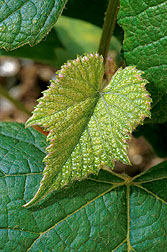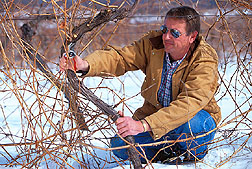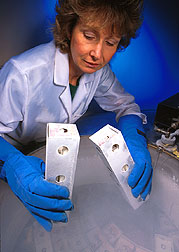Saving Grapes
|
|
If you ask Warren Lamboy to send you Pinot Blanc budwood for plant breeding or other research, you can be sure you won't get a Melon instead—a grape called Melon, that is.
As curator of the Agricultural Research Service's cold-hardy grape collection in Geneva, New York, Lamboy cleared up a case of mistaken identity between the two grape cultivars. And he convinced himself that DNA fingerprinting will ensure accurate identification of the 1,300 accessions at Geneva and of a larger ARS collection of tender, non-cold-hardy grapes at Davis, California.
"Worldwide, there are some 14,000 grape cultivars and wild types and more than 50,000 names for these grapes," explains Lamboy. "The same grape may have three or four names. It takes an expert with at least 10 years of training in identifying grape cultivars to be able to tell them apart visually and by measurements."
The ARS accessions, Lamboy adds, are a combination of disparate collections from U.S. and foreign breeders who've called the same grapes by different names.
"Accurate identification of all these accessions is essential if the two collections are to be reliable sources of grape germplasm," he wrote last year in an article recommending a fingerprinting method—called Simple Sequence Repeats, or SSRs—in the American Journal of Horticultural Science. Most of the SSRs were originally identified by researchers at the University of California at Davis.
Lamboy, a geneticist in the Plant Genetic Resources Unit, didn't start off convinced that differences at specific areas on grape chromosomes would pinpoint each accession. "I'm a skeptic," he says.
So Lamboy selected 45 known grape cultivars from the ARS collection and from colleagues at the Cornell Experiment Station in Geneva, where the ARS unit is located. He also asked former Cornell extension agent Dave Peterson to select several dozen random cultivars from commercial vineyards in the area, but to identify them by number only.
Lamboy says 32 of Peterson's 44 unknowns found matches among his 45 known cultivars. Twelve didn't match. Eleven of them, it turned out, weren't in the original 45; but the twelfth—a Pinot Blanc—should have matched.
|
|
"This made us question the Pinot Blanc standard," which came from the collection of Cornell viticulturist Bob Pool, Lamboy says. Pool then told Lamboy that some experts had identified the standard as Melon. So Lamboy fingerprinted a known Melon sample from Pool's collection and got a perfect match.
"Then I was convinced that DNA fingerprinting really works," he says.
It works, Lamboy explains, because DNA sequences at specific areas, called loci, along the chromosomes repeat themselves. And the number of repeats varies by cultivar. Depending on the locus, Lamboy has found between 16 and 38 differences in the number of repeats. This variation among the cultivars over five loci yields a very large number of possible combinations. In fact, the combined statistical power of all loci allows for only 2 chances in 100 million that any two accessions would not be distinguishable, he says. And that includes wild species and hybrids, as well as cultivated varieties.
"We can sort out the confusion of duplicate names and avoid duplicating accessions," he says.
Knowing What's at the Core
Since Lamboy's evaluation of SSRs 3 years ago, he and colleagues have fingerprinted about one-third of the Geneva grape collection. All 120 accessions of the core collection, which represents the genetic breadth of the whole collection, have been positively identified. "It is one of the most extensively DNA-fingerprinted collections in the National Plant Germplasm System," Lamboy says.
But he didn't stop there. He expanded DNA analysis to show how closely related the various grape accessions are. Under a cooperative research and development agreement with Ernest and Julio Gallo Winery in Modesto, California, Lamboy and Gallo researchers adapted the methods to use Amplified Fragment Length Polymorphisms, or AFLPs, in grapes.
While SSRs positively identify a cultivar from as few as five sites on the grape chromosomes, AFLPs look at many more sites—about 300—and show which and how many sites the cultivars have in common.
He says Gallo will use the method in its search for grapes that possess resistance to diseases or tolerance to environmental stresses. ARS will use it to manage the living grape collections. It will help Lamboy evaluate the quality of the current accessions and identify cultivars that would be useful additions to round out missing characteristics.
For example, nine different cold-hardy grape cultivars have been reported from the Baltic Republics, says Lamboy. "AFLPs may help in determining whether these cultivars carry genes that are not already present in domestic grapes and so would be worthwhile additions to the collection."—By Judy McBride, Agricultural Research Service Information Staff..
This research is part of Plant Microbial and Insect Germplasm, Conservation and Development, an ARS National Program described on the World Wide Web at http://www.nps.ars.usda.gov/programs/cppvs.htm.
Warren F. Lamboy is in the USDA-ARS Plant Genetic Resources Unit, Collier Dr., Cornell University, Geneva, NY 14456-0462; phone (315) 787-2359, fax (315) 787-2339.
"Saving Grapes" was published in the June 1999 issue of Agricultural Research magazine.
DEEP FREEZE—a Really Big Chill
Cryopreservation specialist Susan Sheffer at Geneva, New York, is helping to develop a protocol for deep-freezing and recovering grape germplasm in case diseases, insects, deer, violent weather, or vandals kill the vines growing in the laboratory's vineyards.
"Two years ago," says Sheffer, "we lost 400 apple trees to fire blight. Luckily, every one of them was backed up in a liquid nitrogen tank."
Cryopreservation of grapes is more challenging, says Sheffer, who gets guidance from her coworkers and from experts at ARS' National Seed Storage Laboratory in Fort Collins, Colorado.
To survive freezing, most of the moisture must be removed from the grape bud—otherwise, ice crystals form and rupture the cells.
"The cold-hardy grapes are one story," Sheffer says. "They survive dehydration quite well. But the wine grapes aren't as tolerant, and a third group can't take dehydration at all."
French viticulturists get around this problem by tissue-culturing the buds both before and after freezing—a long and labor-intensive process. Sheffer and Lamboy want to bypass the first culture.
So far, Sheffer has had good success dehydrating cold-hardy grapes to about 20-percent moisture. She hopes to find the secret for dehydrating buds of the tender wine grapes, most of which are kept at the Davis, California, germplasm collection.
Recovering the buds after a deep freeze is another challenge. With apples, much more of the budwood survives dehydration, explains Lamboy, so it can be cut and budded onto rootstock. With grapes, only the tiny growing tip of the bud stays viable after dehydration.
Sheffer uses an outdated dental spoon donated by her dentist to scoop out the tiny, green growing tip from the otherwise dead bud after it has been defrosted and rehydrated. Most of the buds from the cold-hardy grapes she has worked with thrive in glass jars under grow lights.
Sheffer tells visiting schoolchildren, "When you put apple or grape buds into liquid nitrogen, it's just like hitting the 'pause' button on the VCR; it puts them into suspended animation. Then, when you bring them up out of the tank, it's like hitting the 'play' button." Her research is geared to making those transitions successful and efficient.—By Judy McBride, Agricultural Research Service Information Staff.
Susan M. Sheffer is in the USDA-ARS Plant Genetic Resources Unit, Collier Dr., Cornell University, Geneva, NY 14456-0462; phone (315) 787-2359, fax (315) 787-2339.










